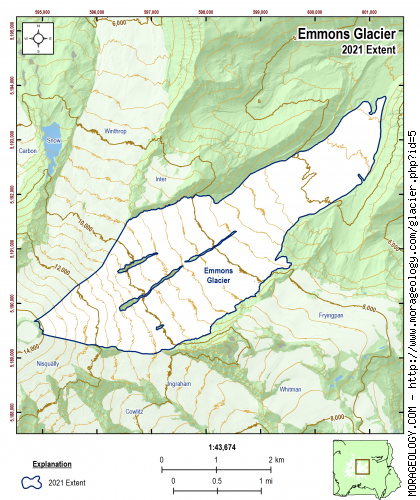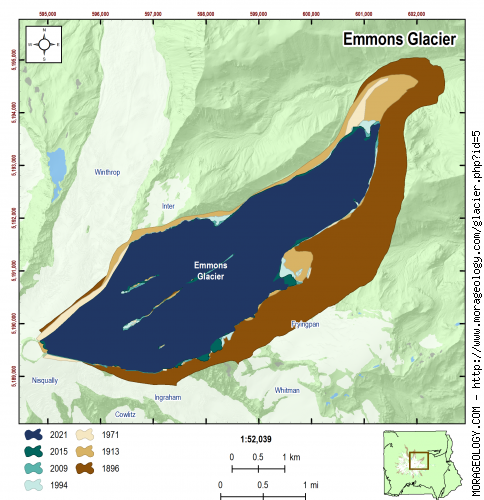NOTE: The data shown here is based on the 2021 glacier update at Mount Rainier, and should be considered the most up-to-date data on glaciers at the park (2023-04-06).
Emmons Glacier
Emmons Glacier, the largest on Mount Rainier, was named for Samuel Emmons who, with A.D. Wilson, made the second successful ascent of Mount Rainier. (Meany, Mount Rainier p. 308). A pamphlet published by Fred G. Plummer of Tacoma lists this glacier as Blaine for Senator James G. Blaine of Maine and it was called the Blaine Glacier by the Seattle Post Intelligencer Expedition of December, 1894. Samuel Franklin Emmons was born in Boston on May 29, 1841. He was an eminent geologist who was part of the U.S. Geological Survey exploration of the 40th parallel. He died March 28, 1911. (Reese, 2009)
Switch Glacier:

|
STATISTICS AS OF 2021 (Beason et al., 2023):
Aerial Extent:
4.231 ± 0.222 square miles
(10.959 ± 0.575 km2)
(Rank: 1 of 29)
Debris Cover - Based on data from 2015 (Beason, 2017):
1.149 ± 0.009 square miles
(2.975 ± 0.023 km2)
(Rank: 3 of 29)
Estimated Glacier Volume: (See notes below)
0.1582 ± 0.0554 cubic miles
(0.6592 ± 0.2307 km3)
Highest Elevation (Head):
14,148 feet
(4,312 m)
Lowest Elevation (Terminus):
4,883 feet
(1,488 m)
Elevation Range:
9,266 feet
(2,824 m)
Length:
4.55 miles
(7.32 km)
Average Slope:
23.77°
Average Flow Direction (direction the glacier flows towards):
Northeast (55°)
Glacier Type:
S - Glacier Head Near Summit |

|
CHANGE IN EXTENT, 1896-2021 (Beason et al., 2023):
| Units |
1896 |
1913 |
1971 |
1994 |
2009 |
2015 |
2021 |
| Area, mi2 |
6.741 |
4.873 |
4.308 |
4.333 |
4.239 |
4.258 |
4.231 |
| Area, km2 |
17.458 |
12.622 |
11.158 |
11.223 |
10.979 |
11.027 |
10.959 |
Area Change Between Periods
|
1913 |
1971 |
1994 |
2009 |
2015 |
2021 |
| 1896 | -1.867 mi2
(-4.836 km2) | -2.432 mi2
(-6.299 km2) | -2.407 mi2
(-6.235 km2) | -2.501 mi2
(-6.479 km2) | -2.483 mi2
(-6.431 km2) | -2.509 mi2
(-6.499 km2) |
|---|
| 1913 | -- | -0.565 mi2
(-1.464 km2) | -0.540 mi2
(-1.400 km2) | -0.634 mi2
(-1.643 km2) | -0.616 mi2
(-1.595 km2) | -0.642 mi2
(-1.663 km2) |
|---|
| 1971 | | -- | 0.025 mi2
(0.064 km2) | -0.069 mi2
(-0.179 km2) | -0.051 mi2
(-0.131 km2) | -0.077 mi2
(-0.199 km2) |
|---|
| 1994 | | | -- | -0.094 mi2
(-0.243 km2) | -0.075 mi2
(-0.196 km2) | -0.102 mi2
(-0.263 km2) |
|---|
| 2009 | | | | -- | 0.019 mi2
(0.048 km2) | -0.008 mi2
(-0.020 km2) |
|---|
| 2015 | | | | | -- | -0.026 mi2
(-0.068 km2) |
|---|
Percent Change Between Periods
|
1913 |
1971 |
1994 |
2009 |
2015 |
2021 |
| 1896 | -27.70% | -36.08% | -35.72% | -37.11% | -36.84% | -37.22% |
|---|
| 1913 | -- | -11.60% | -11.09% | -13.02% | -12.64% | -13.17% |
|---|
| 1971 | | -- | 0.57% | -1.61% | -1.18% | -1.79% |
|---|
| 1994 | | | -- | -2.17% | -1.74% | -2.35% |
|---|
| 2009 | | | | -- | 0.44% | -0.18% |
|---|
| 2015 | | | | | -- | -0.62% |
|---|
|
|
ESTIMATED CHANGE IN VOLUME, 1896-2021 (Beason et al., 2023):
PLEASE see important notes about this, below...
Glacier-specific Scaling Parameter, c:
0.024418
| Units |
1896 |
1913 |
1971 |
1994 |
2009 |
2015 |
2021 |
| Volume, mi3 |
0.2989 |
0.1919 |
0.1621 |
0.1634 |
0.1585 |
0.1595 |
0.1582 |
| Volume, km3 |
1.2461 |
0.7997 |
0.6757 |
0.6810 |
0.6608 |
0.6648 |
0.6592 |
Volume Change Between Periods
|
1913 |
1971 |
1994 |
2009 |
2015 |
2021 |
| 1896 | -0.107 mi3
(-0.446 km3) | -0.137 mi3
(-0.570 km3) | -0.136 mi3
(-0.565 km3) | -0.140 mi3
(-0.585 km3) | -0.139 mi3
(-0.581 km3) | -0.141 mi3
(-0.587 km3) |
|---|
| 1913 | -- | -0.030 mi3
(-0.124 km3) | -0.028 mi3
(-0.119 km3) | -0.033 mi3
(-0.139 km3) | -0.032 mi3
(-0.135 km3) | -0.034 mi3
(-0.140 km3) |
|---|
| 1971 | | -- | 0.001 mi3
(0.005 km3) | -0.004 mi3
(-0.015 km3) | -0.003 mi3
(-0.011 km3) | -0.004 mi3
(-0.016 km3) |
|---|
| 1994 | | | -- | -0.005 mi3
(-0.020 km3) | -0.004 mi3
(-0.016 km3) | -0.005 mi3
(-0.022 km3) |
|---|
| 2009 | | | | -- | 0.001 mi3
(0.004 km3) | 0.000 mi3
(-0.002 km3) |
|---|
| 2015 | | | | | -- | -0.001 mi3
(-0.006 km3) |
|---|
Percent Change Between Periods
|
1913 |
1971 |
1994 |
2009 |
2015 |
2021 |
| 1896 | -35.82% | -45.78% | -45.35% | -46.97% | -46.65% | -47.10% |
|---|
| 1913 | -- | -15.51% | -14.85% | -17.36% | -16.87% | -17.57% |
|---|
| 1971 | | -- | 0.79% | -2.19% | -1.61% | -2.43% |
|---|
| 1994 | | | -- | -2.96% | -2.37% | -3.20% |
|---|
| 2009 | | | | -- | 0.60% | -0.25% |
|---|
| 2015 | | | | | -- | -0.84% |
|---|
Important comments about the calculation of volume shown here
The calculation of glacial volume shown on this page is based on an analysis of two methods used at Mount Rainier in the past (Driedger and Kennard [1986]; and Nylen [2001]) as well as the most recent literature review for glacier area-volume scaling (Please review Beason et al. [2023] for an in-depth discussion about this issue). It should be noted that simply converting area to volume with an equation is extremely difficult and the values presented here have extremely large error margins (likely ± 35% or more). With that in mind, the values presented here should give you an estimate of the glacial volume and change in volume over time. Please use these data very carefully with those caveats.
The calcuation of the volume is as follows:
\[V_i = {(c_iA_i^{1.375}) + (c_nA_i^{1.36}) \over 2}\]
Where:
\(V_i\) = Average volume for the glacier in question (km3);
\(c_i\) = The glacier-specific scaling parameter (back-calculated from glacier area and volume in 1971 in Driedger and Kennard (1986); Method described in Beason et al. (2023). The value for the Emmons Glacier is 0.024418 (this is also listed above the volume graph);
\(c_n\) = The back-calculated scaling parameter from Nylen (2001) of 0.0255; and
\(A_i\) = The measured volume of the glacier in question (km2).
This is essentially an average of the back-calculated Dreidger and Kennard (1986) and Nylen (2001) methods (D&K is in the first parenthesis; Nylen in the second). For example, for the Emmons Glacier in 2021, you can find the following individual volumes:
Back-calculated Dreidger and Kennard (1986) Method: 0.1576 mi3 (0.6568 km3).
Back-calculated Nylen (2001) Method: 0.1587 mi3 (0.6617 km3).
Average of the two (above equation and values listed for 2021 here): 0.1582 mi3 (0.6592 km3).
Official volume estimate listed above, with error: 0.1582 ± 0.0554 mi3 (0.6592 ± 0.2307 km3).
As you can see, the D&K method tends to produce higher values and Nylen produces lower values; the average of these two methods probably estimates the glacial volume. Until further research is done in this area and we can develop a better method or equation to determine volumes, this is the method we are using to determine glacial volumes. For more information about this method, please read the methods section of Beason et al. (2023).
|
NOTES:
-- No Notes supplied --
RAW DATA: